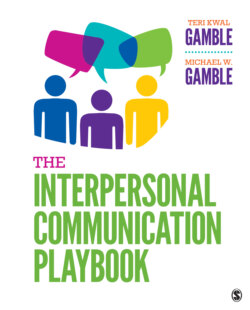Читать книгу The Interpersonal Communication Playbook - Teri Kwal Gamble - Страница 107
На сайте Литреса книга снята с продажи.
Chapter Summary
Оглавление1 Define self-concept, distinguishing it from the self and noting its effect on your communication presence and relationships.□Self-concept, the baseline for communication, is that relatively stable set of perceptions we attribute to ourselves. Composed of everything we think and feel about the self, it guides our communicative behavior. By watching ourselves in action, we see the effect that our communication presence has on others.
2 Define self-esteem, distinguishing high self-esteem from low self-esteem and discussing the effects of each on performance.□Self-esteem is our positive or negative evaluation of our self-concept. We carry it from one interaction to another. Self-esteem that is high nurtures success, while low self-esteem makes its attainment more difficult. When self-esteem is not connected to personal performance, however, it can be self-defeating.
3 Explain reflected appraisal theory, social comparison theory, and confirmation, rejection, and disconfirmation, using them to discuss the role you and others play in shaping the self-concept.□According to reflected appraisal theory, our self-concept reflects how we believe others see us. According to social comparison theory, we compare ourselves to others to develop a feel for how we measure up to them. Confirmation supports our self-appraisal, rejection negates our self-appraisal, and disconfirmation reveals a total disregard for us as a person, suggesting that for the other person, we do not exist, robbing us of a sense of self.
4 Define self-fulfilling prophecy and distinguish between positive and negative Pygmalions.□A self-fulfilling prophecy is a prediction that increases the likelihood that an anticipated outcome will occur. A positive Pygmalion has positive expectations and fosters positive change in us, while a negative Pygmalion has low or no expectations and fosters diminished performance in us.
5 Explain the importance of periodically reexamining and revising your self-concept.□We need to develop the willingness and skills to reevaluate or reinvent ourselves. Only by doing this are we able to shed outdated conceptions.
6 Explain the influence that cultural diversity and gender have on self-concept.□Cultural differences influence our self-notions. Whether we are from an individualistic or collectivistic culture, display an idiocentric or an allocentric orientation, or ascribe to masculine or feminine gender prescriptions is derived from the lessons taught us by society and culture.
7 Describe how media and technology affect self-concept.□Media and technology provide us with information about preferred patterns of behavior and appearance, sometimes causing us to develop unrealistic expectations for ourselves and at times either adversely or positively affecting our feelings of adequacy.
8 Identify how you can change and strengthen your self-concept.□To strengthen our feelings of self-worth, we need to reassess the nature of our self-concept periodically, visit and revisit others’ perceptions of us, and keep ourselves open to the possibility of change.
